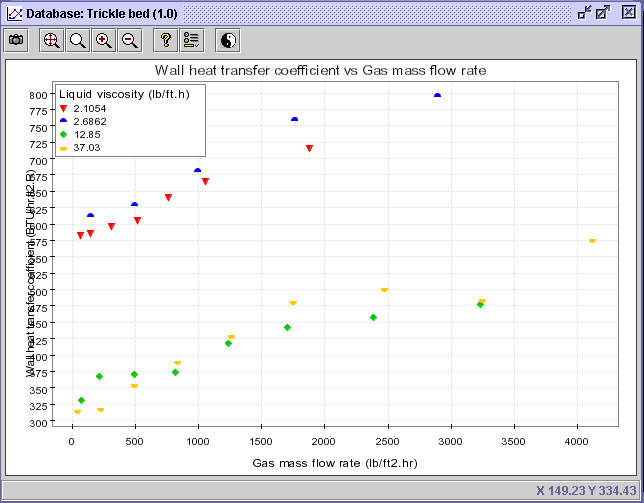 |
 |
 |
Multi_R_Designer
Tutorial |
 |
 |
 |
aaa
Sub-problem 5.1:
General trend for hw in function of liquid viscosity at liquid
mass flow rate of 15000 lb/ft2/hr through beds of glass beads.
1) Before starting a new query,
the default units must be changed from SI to English units.
From
Tools, select the Preferences option and then the Unit
tab. The following dialog window will be presented to the user. Three default
system have been implemented in Multi_R_Designer, namely
SI,
English
and CGS unit systems. Press the English button and all units
will be changed into English units. Press
Apply.
2) Start a new project by
selecting Start new query  .
.
aa
3) Apply the following problem
specifications as described in the problem statement.
-
First, select the Heat transfer
tab and check the box related to Wall heat transfer coefficient,
then Execute. A total of 507 data sets are extracted
from the integrated databank. Then, select the Wall heat transfer
coefficient corresponding pen
 in the Value field. The following dialog window attests that the
minimum-maximum range correspond to 48.42-4930.1 BTU/hr/ft
2/R. Write [300,1600] in the corresponding entry in order
to satisfy the user's specification. Press OK, then
Execute.
A total of 279 data sets satisfies these conditions.
in the Value field. The following dialog window attests that the
minimum-maximum range correspond to 48.42-4930.1 BTU/hr/ft
2/R. Write [300,1600] in the corresponding entry in order
to satisfy the user's specification. Press OK, then
Execute.
A total of 279 data sets satisfies these conditions.
-
Select the Gas tab and check
the Gas density box. Then, select the Wall heat transfer coefficient
corresponding pen
 in the Value field. Write [0.1, 0.3] in the corresponding
entry in order to satisfy the gas density specifications. Press
OK,
then Execute. A total of 157 data sets from
Purwasasmita
(1985) (Publication 4 in
in the Value field. Write [0.1, 0.3] in the corresponding
entry in order to satisfy the gas density specifications. Press
OK,
then Execute. A total of 157 data sets from
Purwasasmita
(1985) (Publication 4 in  )
are extracted.
)
are extracted.
-
In the Liquid tab, check the
Liquid
thermal conductivity box. Then, select the corresponding pen
 in the Value field and write 0.65 in the <= option.
Press OK, then Execute.
in the Value field and write 0.65 in the <= option.
Press OK, then Execute.
4) In order to ease the analysis
on the liquid viscosity effect, a packing type and liquid mass flow rate
will be set. Consequently, select the Reactor tab, check the Packing
type box and then choose Beads from the corresponding combo
list ,
Execute
(Search results: 81 lines).
,
Execute
(Search results: 81 lines).
5) Thereafter, select the
Operating
conditions tab, check the Liquid mass flow rate box and enter
15000
+/- 20% in the appropriate boxes. Press
OK, then Execute.
A total of 29 values on hw will be used to analyse the
effect of liquid viscosity.
a
Comment: Lower extension
percentages (i.e. 5% instead of 20%) would produce an empty search result
list since no liquid mass flow rate from the 81 data sets would
be involved in the corresponding range of 14250-15750 (15000 plus/minus
5%) lb/ft2hr. A warning message appears in those situations.
6) Select the Plot
button  .
In the Horizontal axis panel, choose Gas mass flow rate (Operating
conditions: Gas mass flow rate). In the Vertical axis panel,
choose Experimental (Heat transfer: Wall heat transfer coefficient:
Experimental). In the Advanced panel, select
Liquid viscosity
(Liquid: Liquid viscosity) as the discriminate. Press
OK. The
following diagram will be created.
.
In the Horizontal axis panel, choose Gas mass flow rate (Operating
conditions: Gas mass flow rate). In the Vertical axis panel,
choose Experimental (Heat transfer: Wall heat transfer coefficient:
Experimental). In the Advanced panel, select
Liquid viscosity
(Liquid: Liquid viscosity) as the discriminate. Press
OK. The
following diagram will be created.
7) Select the Discriminate
series button  and check the Value discrimination option. Write 100 in the
Number
of classes box. Press OK.
and check the Value discrimination option. Write 100 in the
Number
of classes box. Press OK.
CONCLUSION: Only a general conclusion can be drawn from
the plot. It shows that high liquid viscosities decrease the heat transfer
coefficient at the reactor's wall (hw) to a relatively large
extent at least between viscosities of 3-10 lb/ft/hr. However, it seems
that a limit is reached at ca. 12 lb/ft/hr where an increase in
the liquid viscosity does not influence anymore hw. For better
heat transfer capacity, low viscosity liquids seems more suited than high
viscosity liquids for example.
 |
 |
 |
Multi_R_Designer
Tutorial |
 |
 |
 |
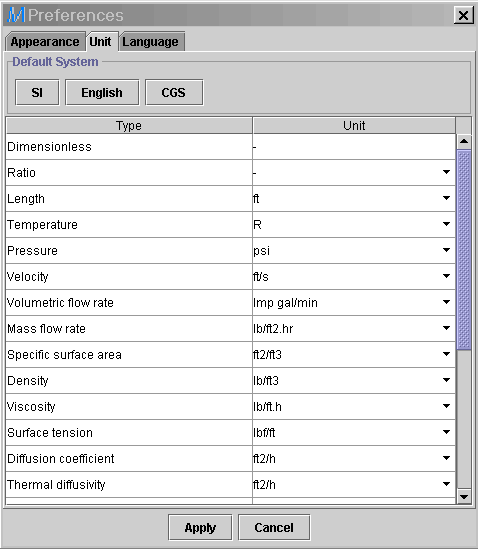
![]() .
.
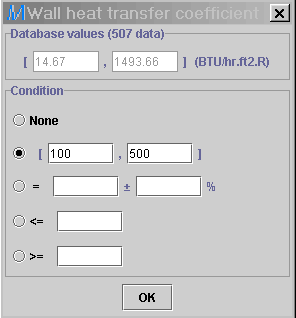
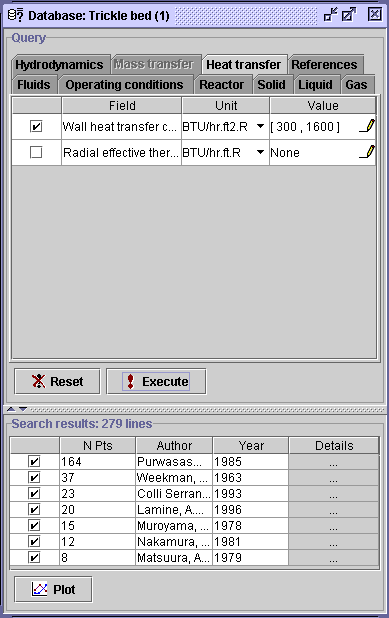
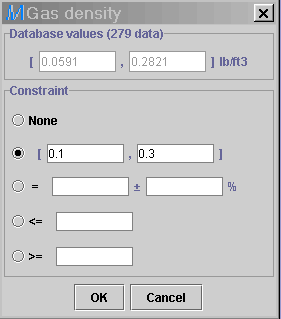
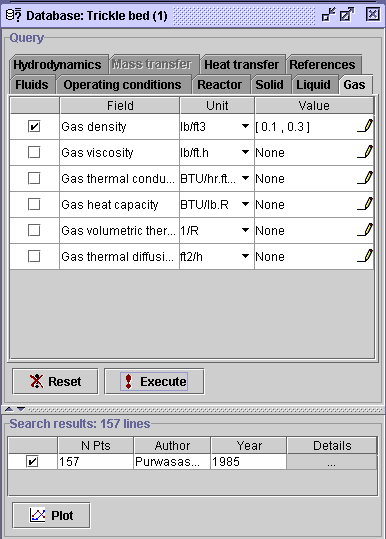
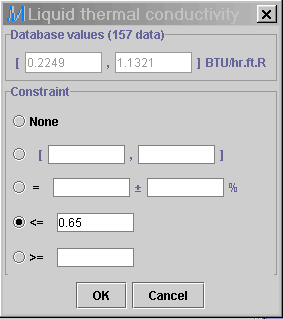
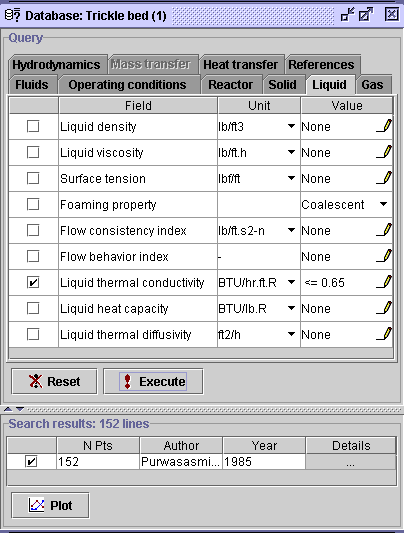
![]() ,
Execute
(Search results: 81 lines).
,
Execute
(Search results: 81 lines).
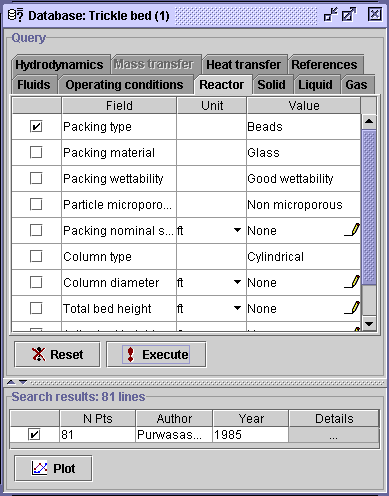
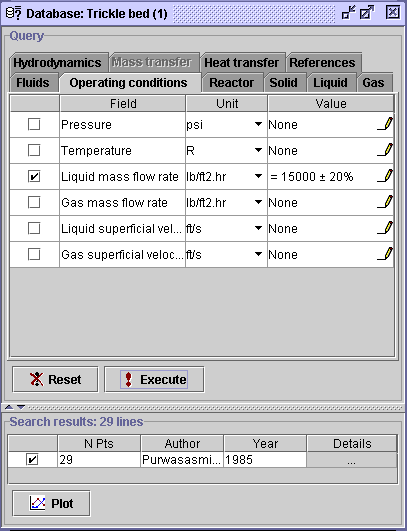
![]() .
In the Horizontal axis panel, choose Gas mass flow rate (Operating
conditions: Gas mass flow rate). In the Vertical axis panel,
choose Experimental (Heat transfer: Wall heat transfer coefficient:
Experimental). In the Advanced panel, select
Liquid viscosity
(Liquid: Liquid viscosity) as the discriminate. Press
OK. The
following diagram will be created.
.
In the Horizontal axis panel, choose Gas mass flow rate (Operating
conditions: Gas mass flow rate). In the Vertical axis panel,
choose Experimental (Heat transfer: Wall heat transfer coefficient:
Experimental). In the Advanced panel, select
Liquid viscosity
(Liquid: Liquid viscosity) as the discriminate. Press
OK. The
following diagram will be created.
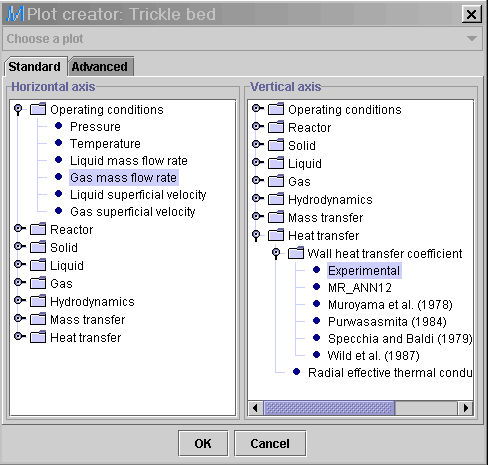
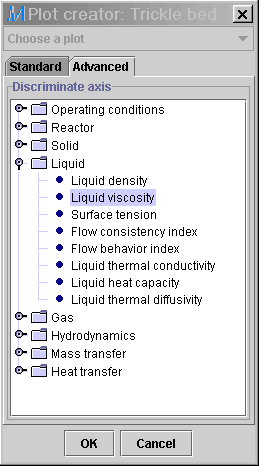
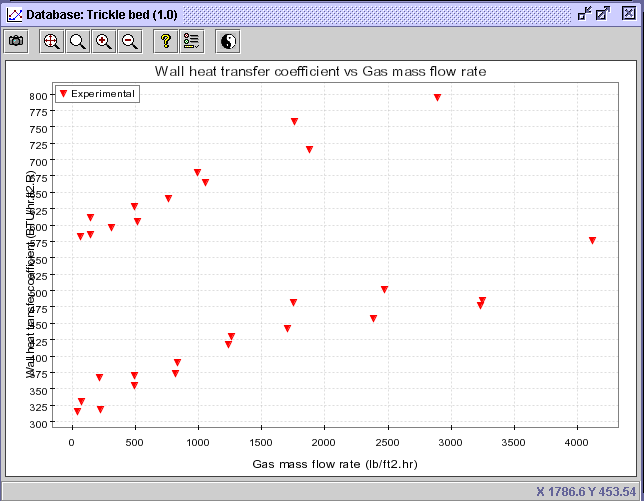
![]() and check the Value discrimination option. Write 100 in the
Number
of classes box. Press OK.
and check the Value discrimination option. Write 100 in the
Number
of classes box. Press OK.
